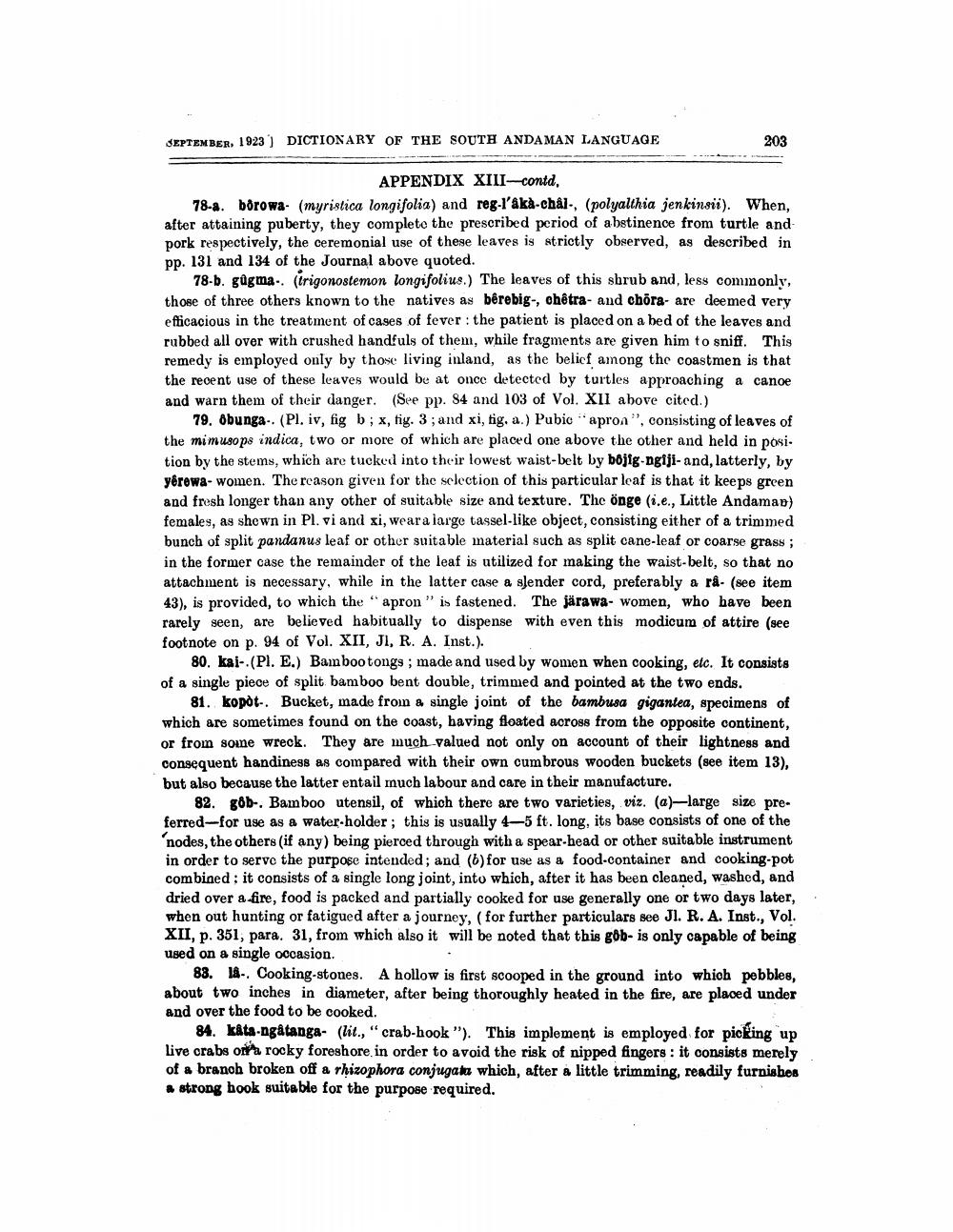________________
SEPTEMBER, 1023) DICTIONARY OF THE SOUTH ANDAMAN LANGUAGE
203
APPENDIX XIII-contd, 78.a. bôrowa (myristica longifolia) and reg-'aka-chål., (polyalthia jenkinsii). When, after attaining puberty, they complete the prescribed period of abstinence from turtle and pork respectively, the ceremonial use of these leaves is strictly observed, as described in pp. 131 and 134 of the Journal above quoted.
78.b. gugma. (Trigonostemon longifolius.) The leaves of this shrub and, less commonly, those of three others known to the natives as bêrebig-, chêtra- and chora- are deemed very efficacious in the treatment of cases of fever: the patient is placed on a bed of the leaves and rubbed all over with crushed handfuls of them, while fragments are given him to sniff. This remedy is employed only by those living inland, as the belief among the coastmen is that the recent use of these leaves would be at once detected by turtles approaching a canoe and warn them of their danger. (See pp. 84 and 103 of Vol. Xll above cited.)
79. Obunga. (Pl. iv, fig b; x, fig. 3; and xi, tig. a.) Pubic apron, consisting of leaves of the mimusops indica, two or more of which are placed one above the other and held in posi. tion by the stems, which are tucked into their lowest waist-belt by bôjig-ngiji-and, latterly, by yêrewa-women. The reason given for the selection of this particular leaf is that it keeps green and fresh longer than any other of suitable size and texture. The onge (i.e., Little Andamap) females, as shewn in Pl. vi and si, weara large tassel-like object, consisting either of a trimmed bunch of split pandanus leaf or other suitable material such as split cane-leaf or coarse grass ; in the former case the remainder of the leaf is utilized for making the waist-belt, so that no attachment is necessary, while in the latter case a slender cord, preferably a rå- (see item 43), is provided, to which the apron" is fastened. The järawa- women, who have been rarely seen, are believed habitually to dispense with even this modicum of attire (see footnote on p. 94 of Vol. XII, JI, R. A. Inst.).
80. kai-(PI. E.) Bamboo tongs, made and used by women when cooking, etc. It consists of a single piece of split bamboo bent double, trimmed and pointed at the two ends.
81. kopot.. Bucket, made from a single joint of the bambusa gigantea, specimens of which are sometimes found on the coast, having floated across from the opposite continent, or from soune wreck. They are much valued not only on account of their lightness and consequent handiness as compared with their own cumbrous wooden buckets (see item 13), but also because the latter entail much labour and care in their manufacture.
82. g8b-. Bamboo utensil, of which there are two varieties, vit. (a)-large size preferred-for use as a water holder; this is usually 4-5 ft. long, its base consists of one of the nodes, the others (if any) being pierced through with a spear-head or other suitable instrument in order to serve the purpose intended; and (b)for use as a food-container and cooking-pot combined: it consists of a single long joint, into which, after it has been cleaned, washed, and dried over a fire, food is packed and partially cooked for use generally one or two days later, when out hunting or fatigued after a journey, ( for further particulars see Jl. R. A. Inst., Vol. XII, p. 351, para. 31, from which also it will be noted that this g6b- is only capable of being used on a single occasion.
83. 14-. Cooking-stones. A hollow is first scooped in the ground into which pebbles, about two inches in diameter, after being thoroughly heated in the fire, are placed under and over the food to be cooked.
84. kata-ngatanga- (lit., "crab-hook"). This implement is employed for picking up Live crabs or rocky foreshore in order to avoid the risk of nipped fingers: it consists merely of a branoh broken off a rhizophora conjugata which, after a little trimming, readily furnishes * strong book suitable for the purpose required.




